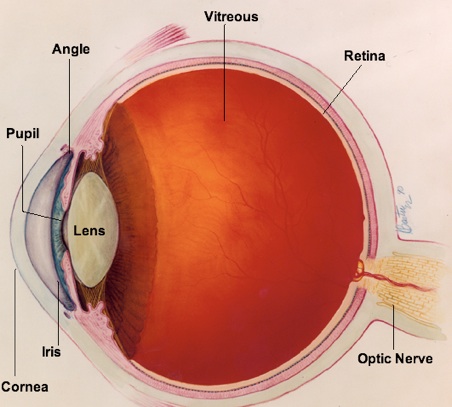Glaucoma

Glaucoma
Glaucoma is a disease of the optic nerve, through which the picture we receive in the eye is transferred to the brain. It contains about a million nerve fibers rather like the wires in an electric cable. Elevated pressure inside the eye may damage the nerve fibers, causing defects in the visual field. The visual field defects develop so gradually that the patient is usually unaware of them until they are very advanced. If all of the nerve fibers are affected, the eye becomes blind.
The early detection of glaucoma will prevent severe visual loss.

What causes high eye pressure and glaucoma?
A clear fluid called the aqueous fills the front part of the eye. It is produced at a constant rate and leaves the eye at the same rate, through a microscopic sieve-like tissue (the trabeculum) situated in the angle of the anterior chamber, between the cornea and the iris. If the rate at which the aqueous leaves the eye slows down, the pressure in the eye goes up.
Risk factors for the development Glaucoma:
Elevated Intra Ocular Pressure
Age over 40
First degree relative to a Glaucoma patient
Myopia
Previous ocular trauma
Diabetes mellitus, systemic hypertension
There are two main types of glaucoma:
Open angle glaucoma is the common type. The anterior chamber angle is open and looks normal, but fluid does not drain properly from the eye because the trabeculum is not functioning properly. The elevated pressure damages the optic nerve so slowly that the patient is usually unaware of any trouble until the visual defect is very advanced.
Angle-closure glaucoma is due to mechanical blockage of the anterior chamber angle by the peripheral iris, in an eye in which that part of the eye is smaller and more crowded than normal. It usually occurs suddenly, accompanied by blurred vision, pain, nausea, vomiting and the appearance of haloes around light sources. The treatment of this type of glaucoma is a matter of urgency.
How can glaucoma be diagnosed before serious damage has occurred to the optic nerve?
People over the age of 40 years should undergo a yearly eye examination, including measurement of the eye pressure, examination of the optic nerve and, in some cases checking the visual fields.

Treatment:
Suitable treatment will prevent further damage to the optic nerve but will not undo the damage that has already been done.
A variety of eye drops are available which reduce the eye pressure by reducing the production of aqueous or by accelerating its drainage from the eye. The drops must be used regularly, often several times a day. Some of the drops have mild side effects which should be reported to your doctor.
Treatment with the YAG laser is very effective for angle-closure glaucoma. Another type of laser treatment may be useful in open angle glaucoma.
Surgical treatment is used when the above methods are not sufficient: the surgeon creates a new drainage channel through which the aqueous drains from the eye, so reducing the pressure.
Remember – damage which has been done cannot be reversed, so it is important to treat glaucoma before serious damage has occurred.


